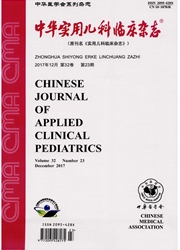

 中文摘要:
中文摘要:
目的分别用4h、8h和12h观察法观察早产儿出生早期的排尿方式,了解3种观察法结果有无差异。方法选取出生1~7d的早产儿32例。男17例,女15例;胎龄32~36^+6(34.2±1.5)周;出生体质量1.2~3.6(2.1±0.6)kg。根据记录排尿时新生儿日龄分为7组(第1—7天组)。每个观察对象连续观察12h,分别对4h、8h和12h记录的排尿参数进行统计学分析。记录排尿参数包括排尿时间、排尿量、残余尿量、排尿时的意识状态(清醒/睡眠)、排尿次数等。结果共记录排尿617次。第1天组11例早产儿出生12h内排尿2~9(5.1±2.2)次,其中4例出生8h内无排尿。第3天组开始发现早产儿排尿前有手臂或大腿微动或排尿后有啼哭。7组早产儿12h内排尿次数差异无统计学意义,但均存在明显的间断排尿模式。第2天组、第4天组、第5天组和第6天组4h与12h排尿频率差异有统计学意义(P均〈0.01);第4天组8h与12h差异有统计学意义(P〈0.05)。不同时段每次排尿量、残余尿量在所有组中差异均无统计学意义(P均〉0.05)。残余尿量个体变化大(0—30mL),次残余尿量随日龄变化不明显。结论用4h观察法可以推测出生7d内新生儿8h和12h内排尿量、残余尿量,但不能替代8h和12h观察法观察的排尿频率。
 英文摘要:
英文摘要:
Objective To explore the possibility of using 4,8, and 12 hours voiding observation to evaluate the bladder function in early birth in premature infants, and understand the differences among the 3 observation methods. Methods A total of 32 premature infants were selected, 17 cases were male, 15 cases were female;their gestational age were 32 - 36^+6 (34.2 ± 1.5 ) weeks ; their birth weight were 1.2 - 3.6 (2.1 ± 0.6) kg; and they were divided into 7 groups according to the day age. Free voiding pattern was recorded for 12 hours,and the parameters included voiding time (VT), voiding volume (VV), post-void residual volume (PRV), state of consciousness at voiding, and voiding fre- quency(VF) per hour were recorded. The recorded voiding parameters of 4 hours were compared with those of 12 hours. Results A total of 617 times voiding cycles were recorded. Between different time schedules and groups, sig- nificant difference of VF per hour existed and significant difference of VV, PRV was not found. In day 1 group, 11 pa- tients were observed in the period starting from 12 h after birth, no voiding was found in 4 cases. From the 3^rd day after birth,the phenomenon was observed of these newborn's moving arms and/or legs or crying before voiding. Conclusion Four-hour observation can be used to determine the VV and PRV but not VF in the premature early newborn.
 同期刊论文项目
同期刊论文项目
 同项目期刊论文
同项目期刊论文
 期刊信息
期刊信息
